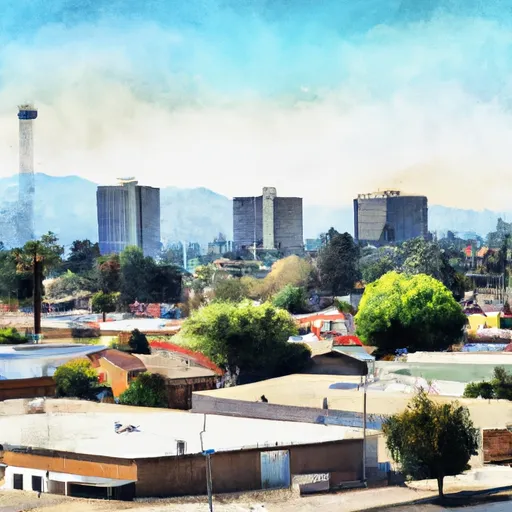-
 Snoflo Premium
Snoflo Premium
Get unlimited access to all our content
With no Ad interruptions! - Start Your Free Trial Login with existing account
Reseda
Eden Index
Climate
9.3
•
Recreation
4.2
•
Community
3.7
•
Safeguard
6.1/10

Reseda, California is a vibrant neighborhood located in the San Fernando Valley of Los Angeles. The climate in Reseda is Mediterranean, characterized by warm, dry summers and mild, wet winters. Summers are hot, with temperatures often reaching the high 80s to mid-90s Fahrenheit, while winters are mild with temperatures averaging in the 60s. Reseda experiences minimal rainfall, typically occurring during the winter months.
In terms of hydrology constituents, Reseda is not directly located near any major bodies of water. However, it is part of the Los Angeles River watershed, which provides some hydrological connectivity to nearby water sources. The Los Angeles River is a prominent feature in the region, offering opportunities for outdoor activities such as hiking, biking, and bird-watching along its banks.
Apart from the Los Angeles River, Reseda is also home to several parks and recreational areas. Reseda Park, for instance, offers amenities like sports fields, picnic areas, and playgrounds. Nearby, the Santa Monica Mountains provide opportunities for hiking, mountain biking, and exploring nature trails. With its pleasant climate and diverse outdoor recreational options, Reseda is an appealing destination for nature enthusiasts and outdoor lovers.
What is the Eden Index?
The Snoflo Eden Index serves as a comprehensive rating system for regions, evaluating their desirability through a holistic assessment of climate health, outdoor recreation opportunities, and natural disaster risk, acknowledging the profound impact of these factors on livability and well-being.
Climate Health Indicator (CHI): 9.3
Reseda receives approximately
418mm of rain per year,
with humidity levels near 58%
and air temperatures averaging around
19°C.
Reseda has a plant hardyness factor of
10, meaning
plants and agriculture in this region tend to thrive here all year round.
By considering the ideal temperature range, reliable water supplies, clean air, and stable seasonal rain or snowpacks, the Climate Health Indicator (CHI) underscores the significance of a healthy climate as the foundation for quality living.
A healthy climate is paramount for ensuring a high quality of life and livability in a region, fostering both physical well-being and environmental harmony. This can be characterized by ideal temperatures, reliable access to water supplies, clean air, and consistent seasonal rain or snowpacks.
Weather Forecast
Streamflow Conditions
Ventura-San Gabriel Coastal
Area Rivers
Ventura-San Gabriel Coastal
Snowpack Depths
Ventura-San Gabriel Coastal
Reservoir Storage Capacity
Ventura-San Gabriel Coastal
Groundwater Levels
Recreational Opportunity Index (ROI): 4.2
The Recreational Opportunity Index (ROI) recognizes the value of outdoor recreational options, such as parks, hiking trails, camping sites, and fishing spots, while acknowledging that climate plays a pivotal role in ensuring the comfort and consistency of these experiences.
Access to outdoor recreational opportunities, encompassing activities such as parks, hiking, camping, and fishing, is crucial for overall well-being, and the climate plays a pivotal role in enabling and enhancing these experiences, ensuring that individuals can engage in nature-based activities comfortably and consistently.
Camping Areas
| Campground | Campsites | Reservations | Toilets | Showers | Elevation |
|---|---|---|---|---|---|
| Castaic Lake | 60 | 1,184 ft | |||
| Spunky | 10 | 3,191 ft | |||
| Dockweiler Beach RV | 117 | 45 ft | |||
| Tapo Canyon Co Park | 16 | 1,373 ft | |||
| Malibu Creek - State Park | 63 | 555 ft | |||
| Streamside | 9 | 2,364 ft |
Catastrophe Safeguard Index (CSI):
The Catastrophe Safeguard Index (CSI) recognizes that natural disaster risk, encompassing floods, fires, hurricanes, and tornadoes, can drastically affect safety and the overall appeal of an area.
The level of natural disaster risk in a region significantly affects safety and the overall livability, with climate change amplifying these risks by potentially increasing the frequency and intensity of events like floods, fires, hurricanes, and tornadoes, thereby posing substantial challenges to community resilience and well-being.
Community Resilience Indicator (CRI): 3.7
The Community Resilience Indicator (CRI) recognizes that education, healthcare, and socioeconomics are crucial to the well-being of a region. The CRI acknowledges the profound impact of these elements on residents' overall quality of life. By evaluating educational resources, healthcare accessibility, and economic inclusivity, the index captures the essential aspects that contribute to a thriving community, fostering resident satisfaction, equity, and social cohesion.

